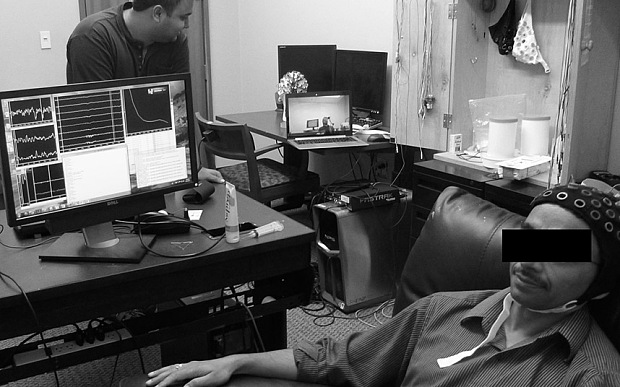|
Taking control of another person's body with your mind is something that has been long dreamed of in comic books and films like X Men, but now scientists have achieved it in real life.
Researchers used electromagnets and computers to transmit a person's brainwaves allowing them to control the hand of another sitting in a different building one mile away.
The technology recorded the brain signals from a computer gamer and then fired them into the brain of another volunteer, triggering the nerves that controlled their hand muscles.
This allowed the gamer, who had no physical computer controls themselves, to use the other person to play a computer game.
The technology makes it possible to control the body of another person with thoughts - something that Professor Xavier was able to do in the X Men.
The researchers behind the project believe it may eventually lead to new ways of helping rehabilitate stroke patients and those who have suffered brain damage.
It could also be used to pass information between people or allow skilled surgeons help others perform difficult operations from miles away or allow pilots to take control of a plane from the ground in an emergency.
Dr Rajesh Rao, a computer scientist and engineer at the University of Washington who led the work, said: "Our results show that information extracted from one brain can be transmitted to another brain, ultimately allowing two humans to cooperatively perform a task using only a direct brain-to-brain interface.
"Such devices, which have been long cherished by science fiction writers, have the potential to not only revolutionize how humans communicate and collaborate, but also open a new avenue for investigating brain function."
In the study, which is published in the journal Public Library of Science One, three pairs of volunteers played a rudimentary computer game where they had to fire a canon at passing pirate ships.
While one volunteer could see what was happening on the screen, the other in a different building could not see the screen but had their hand placed over a keypad needed to fire the canon.
The gamer who could see the screen was fitted with electroencephalograph, or EEG, to record the minute electrical signals that are given off by their brain.
With this they were able to transmit a distinctive signal to tap the keypad over the internet to a device that stimulated the brain of the second volunteer in the other room.
The signal was transmitted into the brain of the second volunteer through transcranial magnetic stimulation, or TMS, which generates an electromagnetic pulse that triggers the neurons in their brain.
When positioned over the part of the brain that controls movement in the right hand, this caused the muscles in volunteer's hand to move and tap the keypad.
The researchers, whose study said the technology needed little training for the volunteers to use and it was possible to trigger movement in the receiving person's hand less than 650 milliseconds after the sender gave the command to fire.
They found that the accuracy varied between the pairs with one managing to accurately hit 83 per cent of the pirate ships. Most of the misses were due to person sending the thoughts failing to accurately execute the thought needed to send the "fire" command.
Early brain to computer communication devices required many hours of training and required surgical implants.
Scientists have already enabled paralysed patients to control robotic arms and play computer games.
However, Dr Rao and his team believe their technology can be used by people who have just walked into their lab and do not require any invasive implants.
Recently scientists in Spain and France were able to show that they could send words to colleagues in India using similar set ups.
Those researchers recorded electrical activity from the brain and converted the words "hola" and "ciao" into a digital signal before electromagnetic pulses transmitted them into the receivers brain so they saw flashes of light that formed a kind of morse code.
Dr Rao and his team have now been given a $1 million grant from the WM Keck Foundation to transmit more complex brain processes.
They believe it may be possible to transmit other information such as concepts, abstract thoughts and rules as well as physical movement and information.
Dr Andrea Stocco, a psychologist at the University of Washington who was also involved in the study, said: "We have envisioned many scenarios in which brain-to-brain technology could be useful.
"A skilled surgeon could remotely control an inexperienced assistant's hands to perform medical procedures even it not on the site, or a skilled pilot could remotely help a less experienced one control a plane during a difficult situation.
"It could help with neuro-rehabilitation. After brain damage, patients need to painfully and slowly re-learn simple motor actions, such as walking, grasping, or swallowing.
"We suspect that the re-learning phase could be greatly sped-up if we could provide the damaged brain with a "motor template", copied from a healthy person, or the healthy part of the patient's brain, of what the intended action should look like.
"It could also help with tutoring. Imagine that we could extract the teacher's richer representation of a difficult concept and deliver it to his or her students in terms of neural activity."
|
人類一直以來夢想用意念控制他人身體,《X戰(zhàn)警》等漫畫和電影都曾描繪過這樣的場景。現(xiàn)在,科學(xué)家已將這個(gè)夢想變?yōu)楝F(xiàn)實(shí)。
研究者使用電磁體和計(jì)算機(jī)傳送一個(gè)實(shí)驗(yàn)對象的腦波,讓這些腦波控制的另一個(gè)實(shí)驗(yàn)對象的手,而這個(gè)人坐在一英里外的不同建筑內(nèi)。
該技術(shù)先把一個(gè)計(jì)算機(jī)游戲玩家的腦波記錄下來,然后再將這些腦波發(fā)射到另一名志愿者的腦中,以觸發(fā)其控制手部肌肉的神經(jīng)。
這樣就可以讓那位無實(shí)體計(jì)算機(jī)操作的玩家通過他人玩游戲。
該項(xiàng)技術(shù)讓人們用意念控制他人身體成為可能——就跟《X戰(zhàn)警》中X教授查爾斯所具備的能力一樣。
項(xiàng)目研究者相信,該技術(shù)最終可以提出新的方法,以協(xié)助康復(fù)中風(fēng)病人及那些遭受腦損傷的人。
該項(xiàng)技術(shù)還可用于人與人之間的交流,或者讓技能嫻熟的外科醫(yī)生協(xié)助遠(yuǎn)在幾英里外的其他醫(yī)生做頗有難度的手術(shù)。此外,它可以讓飛行員在緊急情況下從地面控制一架飛機(jī)。
主導(dǎo)這項(xiàng)研究的華盛頓大學(xué)計(jì)算機(jī)科學(xué)家和工程師羅杰西·拉奧(Rajesh Rao)博士說,“我們的研究結(jié)果顯示,從某人頭腦獲取的信息可傳送到他人的腦中。只需通過一個(gè)直接的腦對腦程序接口,就可以讓兩人共同合作完成任務(wù)。”
“這種設(shè)備一直以來深受科幻小說家的推崇,它們不僅有望徹底改變?nèi)祟愅ㄓ嵑秃献鞣绞剑矣锌赡転樘剿鞔竽X功能開辟一條林蔭大道。”
這項(xiàng)研究發(fā)表在《公共科學(xué)圖書館》雜志上。實(shí)驗(yàn)中,三對志愿者玩一款簡單的電腦游戲——他們必須朝駛過的海盜船發(fā)射炮火。
每對志愿者中有一位可以看到屏幕,在不同建筑物的另一位則看不到屏幕,但需要把手放到鍵盤上以備發(fā)射炮火。
腦電圖儀配備(EEG)給可以看到屏幕的那位玩家,以記錄這兩位玩家大腦發(fā)出的微弱電子信號(hào)。
憑借這種方法,他們能夠把敲擊鍵盤的特殊信號(hào)通過網(wǎng)絡(luò)傳輸?shù)揭慌_(tái)促發(fā)第二位志愿者大腦活動(dòng)的設(shè)備上(該志愿者在另一間房)。
這種信號(hào)通過“經(jīng)顱磁刺激”(TMS)產(chǎn)生激發(fā)大腦神經(jīng)的電磁脈沖,傳送到第二位志愿者的大腦。
當(dāng)信號(hào)到達(dá)腦中控制右手運(yùn)動(dòng)的部位時(shí),就會(huì)促使志愿者的手部肌肉產(chǎn)生敲擊鍵盤的動(dòng)作。
研究者的研究表明,該技術(shù)操作方便,不需要對志愿者進(jìn)行培訓(xùn)就能使用。發(fā)送者發(fā)出開火的指令后,接收者在650毫秒內(nèi)就能收到該指令并促發(fā)自己的手部動(dòng)作。
他們發(fā)現(xiàn),每對志愿者的準(zhǔn)確性有所不同,其中有一對成功消滅了83%的海盜船。沒有打中的大部分原因可以歸結(jié)為,傳送意念的那位未能準(zhǔn)確執(zhí)行負(fù)責(zé)發(fā)射炮火的命令。
早期的腦-機(jī)通訊設(shè)備需要使用者訓(xùn)練很長時(shí)間,而且需要通過外科手術(shù)往人體內(nèi)植入芯片等。
科學(xué)家已經(jīng)能夠讓癱瘓病人操控機(jī)械臂玩電腦游戲。
但羅杰西·拉奧博士和他的團(tuán)隊(duì)認(rèn)為,他們的技術(shù)更為先進(jìn),人們走進(jìn)實(shí)驗(yàn)室,不需要通過訓(xùn)練就能使用,也不需要植入任何侵入人體的東西。
最近,西班牙和法國的科學(xué)家已能夠向人們展示,他們能夠使用類似的設(shè)備把要說的話成功地傳送給在印度的同事。
這些研究者將大腦產(chǎn)生的電子活動(dòng)記錄下來,并把"hola"和"ciao"這兩個(gè)詞轉(zhuǎn)換成數(shù)字信號(hào),然后電磁脈沖再把它們傳送到接收者大腦中,這樣接收者就可以看到以莫爾斯電碼形式出現(xiàn)的閃光。
目前,WM Keck基金會(huì)已給羅杰西·拉奧博士和他的團(tuán)隊(duì)提供了一筆一百萬美元的經(jīng)費(fèi),以期推進(jìn)更復(fù)雜的大腦傳輸研究。
他們相信,將來有可能實(shí)現(xiàn)傳送概念、抽象思維和規(guī)則以及身體運(yùn)動(dòng)之類的其它信息。
華盛頓大學(xué)心理學(xué)研究者安德里亞·斯托科(Andrea Stocco)博士也參與了這項(xiàng)研究,他說:“我們設(shè)想了很多‘腦對腦科技’發(fā)揮作用的場景。
“技術(shù)嫻熟的外科醫(yī)生能夠在不在場的情況下,通過遙控經(jīng)驗(yàn)尚淺的助手給病人做手術(shù)。缺乏經(jīng)驗(yàn)的飛行員面臨困境時(shí),經(jīng)驗(yàn)豐富的飛行員可遠(yuǎn)程協(xié)助其操控飛機(jī)。
“它可以幫助恢復(fù)神經(jīng)。大腦損傷之后,病人需要痛苦而緩慢地重學(xué)簡單的肌肉運(yùn)動(dòng),比如走路、抓握、吞咽。
“我們認(rèn)為,可以從健康的人或病人未受損的大腦部位復(fù)制一份‘運(yùn)動(dòng)神經(jīng)模板’,并提供給受損的大腦,這樣就能大大加速這種重學(xué)過程。
“它也能助教學(xué)一臂之力。想象一下,我們可以從教師腦中獲取其對復(fù)雜概念的生動(dòng)有趣的表述,并通過神經(jīng)活動(dòng)將之傳送給他或她的學(xué)生。”
(譯者?li2013 編輯 祝興媛)
掃一掃,關(guān)注微博微信
 
|

